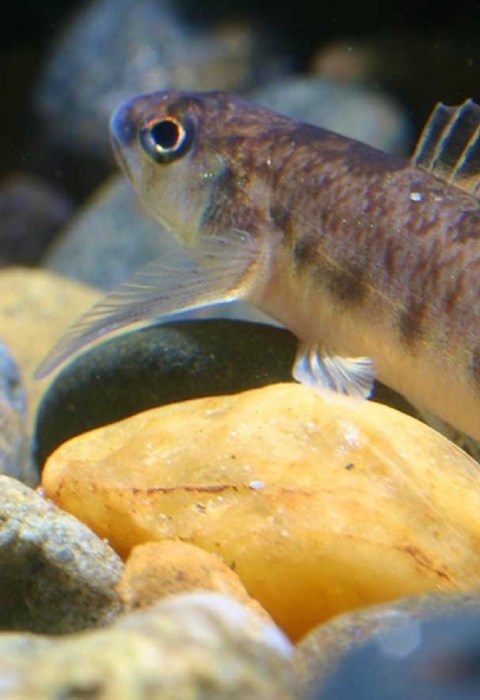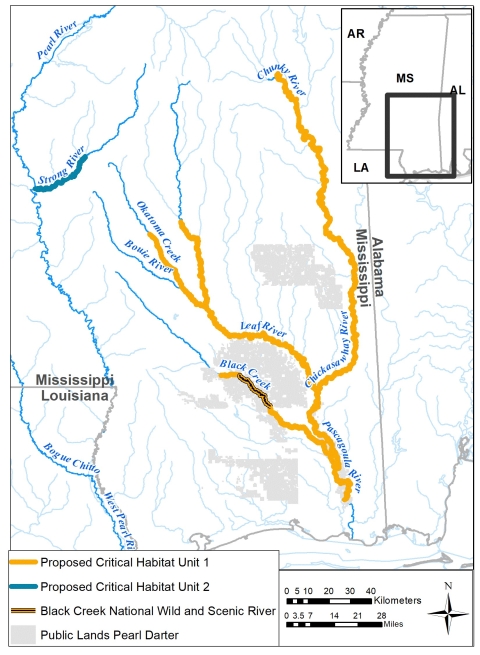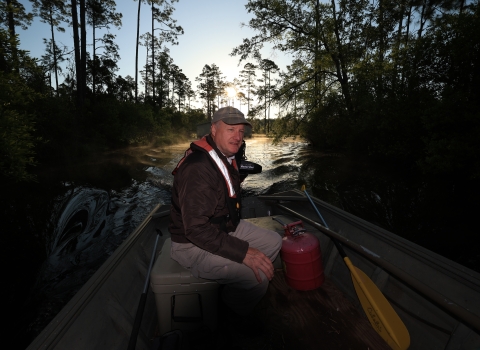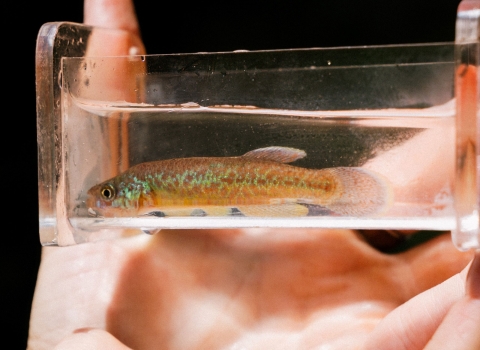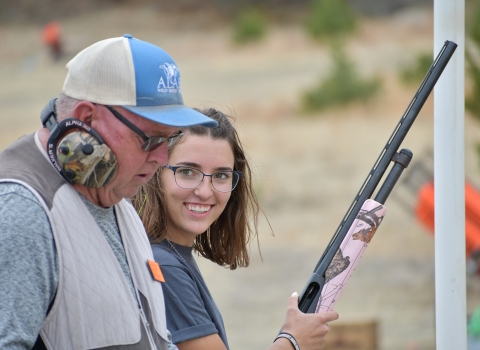What is the pearl darter?
The pearl darter (Percina aurora) is a small (2 to 2.5 inches long) snub-nosed fish found in pools or deep runs of flowing streams and rivers. It is a bottom dwelling species generally found over sand, gravel, or bedrock in slow to moderate currents.
Where does it occur?
Native to the Pascagoula River system of Mississippi and the Pearl River system of Mississippi and Louisiana, pearl darters continue to survive in the Pascagoula River system but have not been seen in the Pearl River system for more than 40 years.
What are the main threats to the pearl darter?
Threats to the pearl darter surviving in the Pascagoula River system include nonpoint-source pollution (land-surface and stormwater runoff) and point-source pollution, such as wastewater discharged from treatment plants and industrial sites. Because of its limited distribution and small population size, the darter is also vulnerable to random threats such as spills and weather events (e.g., drought, floods).
What action is the U.S. Fish and Wildlife Service taking?
On September 20, 2017, the Service published a final rule listing the pearl darter as a threatened species. At the time of listing, the economic analysis required for a proposed critical habitat designation was not complete, leading the Service to find that critical habitat was not determinable. That draft economic analysis, as well as pertinent biological information, are now available to make the determination and to analyze the impacts of the proposed designation. Accordingly, the Service is proposing to designate critical habitat for the pearl darter and is announcing the availability of a draft economic analysis (DEA) of the proposed designation.
What exactly is critical habitat?
Critical habitat is specific geographic areas that contain features essential to the conservation of an endangered or threatened species that may require special management and protection. Critical habitat may also include areas that are not currently occupied by the species but will be needed for its recovery.
Establishing critical habitat raises awareness of the needs of a species and helps to focus the efforts of our conservation partners. It also alerts federal agencies that they are required to make special conservation efforts when they work, fund or permit activities in those areas. The designation will have no impact on private landowners taking actions on their land that do not require federal funding or permits.
How does the Service determine what areas to designate as critical habitat?
Within areas occupied by the species, biologists consider physical or biological features needed for life processes. These include:
space for individual and population growth and for normal behavior;
cover or shelter;
food, water, air, light, minerals, or other nutritional or physiological requirements;
sites for breeding and rearing offspring; and
habitats that are protected from disturbances or are representative of the historical geographical and ecological distributions of a species.
After considering occupied areas, biologists consider unoccupied areas that may be essential for the conservation of the species.
What is the proposed critical habitat for the pearl darter?
After evaluating the life-history of the pearl darter, the Service is proposing to designate a total of 517 stream miles as critical habitat for the pearl darter in south Mississippi within Clarke, Covington, Forrest, George, Greene, Lauderdale, Jackson, Jones, Newton, Perry, Simpson, Stone, and Wayne Counties. The proposed critical habitat consists of two units, with one unit in the Pascagoula River drainage (487 miles – occupied) and a second unit in the Pearl River drainage (30 miles – not occupied but historically occupied).
The single population within the Pascagoula River drainage provides no alternative for the species to withstand or recover from catastrophic events, hampering the species overall capacity for recovery. This necessitates the proposed designation of the unoccupied unit in the Strong River, a major tributary of the Pearl River.
The proposed critical habitat does not include riparian riparian
Definition of riparian habitat or riparian areas.
Learn more about riparian areas, only instream habitat (stream and river channels) within the ordinary high water line and contains those physical or biological features identified as essential to the conservation of the pearl darter. Those are:
Unobstructed stream and river channels, with connected sequences of channel runs and bends, and with pools and scour holes;
Stable stream and river channels, with bottom substrates of fine and coarse sand, gravel, bedrock, silt, clay, organic matter and woody debris;
A natural flow regime necessary to maintain habitats and connectivity of stream and floodplain habitats;
Water quality conditions necessary to maintain the species, including cool to warm water temperatures (17 – 30 C), high dissolved oxygen (5.8 – 9.3 ppm), slightly acid to basic pH (6.3 – 7.6), and low levels of pollutants and nutrients (not less than State criteria); and
The presence of a prey base of small aquatic macroinvertebrates, including midges, crustaceans, mayflies, caddisflies, and zooplankton.
What was the finding in the draft economic analysis?
The draft economic analysis report found that the economic cost of implementing the rule will likely be limited to additional administrative effort in considering adverse modification of pearl darter habitat during Section 7 Section 7
Section 7 Consultation
The Endangered Species Act (ESA) directs all Federal agencies to work to conserve endangered and threatened species and to use their authorities to further the purposes of the Act. Section 7 of the Act, called "Interagency Cooperation," is the mechanism by which Federal agencies ensure the actions they take, including those they fund or authorize, do not jeopardize the existence of any listed species.
Learn more about Section 7 consultations. Both proposed units are occupied by other federally listed species like the Gulf sturgeon, yellow-blotched map turtle, and ringed map turtle, as well as designated critical habitat for the Gulf sturgeon. Conservation measures to avoid or minimize impacts to those listed aquatic species will likely be the same for avoiding or minimizing impacts to pearl darter habitat and are not expected to trigger additional requirements under state or local regulations.
How do I submit comments on the proposed critical habitat and draft economic analysis?
The public is invited to submit comments on both the proposed critical habitat designation and draft economic analysis during a 60-day comment period ending September 13, 2021. Comments submitted electronically using the Federal eRulemaking Portal (see ADDRESSES below) must be received by 11:59 p.m. Eastern Time on the closing date. We must receive requests for public hearings, in writing, at the address shown in ADDRESSES by August 27, 2021.
ADDRESSES: You may submit comments on the proposed rule or draft economic analysis by one of the following methods:
(1) Electronically: Go to the Federal eRulemaking Portal: http://www.regulations.gov. In the Search box, enter FWS–R4–ES–2020–0062, which is the docket number for this rulemaking. Then, click on the Search button. On the resulting page, in the Search panel on the left side of the screen, under the Document Type heading, check the Proposed Rule box to locate this document. You may submit a comment by clicking on “Comment Now!”
(2) By hard copy: Submit by U.S. mail to: Public Comments Processing, Attn: FWS–R4–ES–2020–0062, U.S. Fish and Wildlife Service, MS: PRB/3W, 5275 Leesburg Pike, Falls Church, VA 22041–3803.
We request that you send comments only by the methods described above. We will post all comments on http://www.regulations.gov. This generally means that we will post any personal information you provide us (see Information Requested, below, for more information).
Document availability: The draft economic analysis is available at Mississippi Ecological Services Field Office and at http://www.regulations.gov under Docket No. FWS–R4–ES–2020–0062.
The coordinates or plot points or both from which the maps are generated are included in the administrative record for this critical habitat designation and are available at Mississippi Ecological Services Field Officeand at http://www.regulations.gov under Docket No. FWS–R4–ES–2020–0062. Any additional tools or supporting information that we may develop for this critical habitat designation will also be available at the Service website and Field Office set out above, and may also be included in the preamble and/or at http://www.regulations.gov.
FOR FURTHER INFORMATION CONTACT: Stephen Ricks, Field Supervisor, U.S. Fish and Wildlife Service, Mississippi Ecological Services Field Office. Persons who use a telecommunications device for the deaf (TDD) may call the Federal Relay Service at 800–877–8339.
